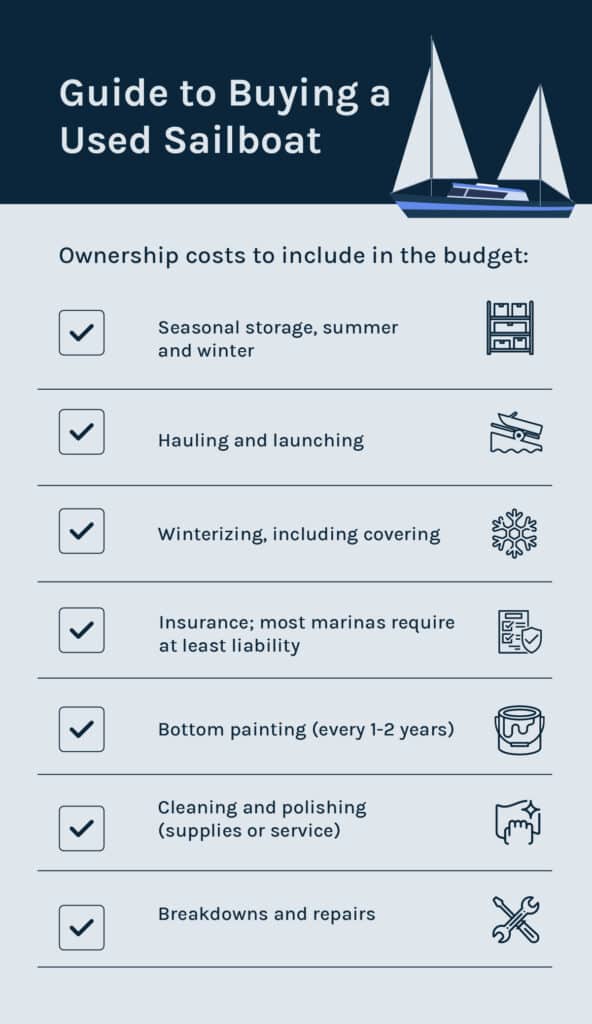
Buying a used sailboat is a great way to get a good boat for a good price. Whether you’re looking for a low-priced older boat, or for something newer, the search for the right used boat can be long and tricky.

What Will You Do With Your Boat?
The answer will drive your choice because a boat for casual weekend cruising and day sailing differs greatly from one exclusively for racing in competitive events. If you want to do a mix – some sleeping on board and some weeknight racing near home – that’s another kind of boat.
Decide what you’d like to do with your boat, then you can prioritize what features like speed, comfort, and living space matter to find the right type of sailboat (1).
Make a Budget
Buying the sailboat is only the first expense. Most used boats require work, and every boat has ownership costs. You’ll need estimated costs for storage in a slip or mooring, insurance, any short-term upgrades or replacements, and ongoing maintenance.
Sailboats may list as “completely refit” or with a “nearly new sail inventory,” but most used boats have older systems and components, and sails often aren’t in great shape. Storage and hauling costs are priced by foot, so a forty-foot boat costs the same to dock whether you paid $5,000 or $250,000 for it.
Budget 20-30% of the purchase price for upgrades and refits over the first two years, and 10-15% of the purchase cost in annual maintenance and operating costs. Do some research on year-round storage and get firm quotes.
You can finance a used boat if it’s not too small or too old. If that is your plan, factor the down payment (10-20%) and monthly payments into your costs.
Look at Some Sailboats

Once you’ve got your budget and your wish list of features, you’re ready to look at boats. You’ll find brokerage-listed vessels on sites like YachtWorld, while sailboats for sale by owner will be in a variety of places, from boat-for-sale sites like Boatrader.com to Craigslist and Facebook Marketplace.
Pay close attention to pictures, but don’t get too excited about large equipment and gear lists. Much of what comes with a used sailboat will need to be replaced or updated within the first year or two, anyway. Avoid listings with dirty boats and cluttered pictures. It will not look any better in person.
Working With the Broker
If it’s a brokerage-listed boat, contact the broker for a showing, or have your buyer’s broker reach out if you’re using one. Your broker should attend the showing, the listing broker may not if you have your own broker, though a good one won’t miss the opportunity to talk up the boat.
What to Look For
Whether it’s the listing broker or the owner at the showing, make a list of questions to ask. If the broker doesn’t know, they’ll ask the owner and get back to you. Good questions include:
- When was the engine last professionally serviced?
- Is there a maintenance log?
- Has the boat had any hard groundings or collisions?
- How old are the sails, and how much have they been used?
- How old are the standing and running rigging?
- When was the last time the mast was taken down?
You might also be interested in: How to Restore a Fiberglass Boat: Fiberglass Boat Restoration Tips
Feel free to come up with more questions as you poke around the boat, and don’t be afraid to look inside lockers and the engine compartment, and ask to look under cushions and floorboards.
When you’re on the sailboat, pay close attention to details like water stains, unpleasant smells, rust and corrosion, mold, mildew, dodgy wiring, and general wear (2). It’s easy to get excited about pretty lines and a shiny hull, but you don’t want hidden problems.
Make an Offer
Is the asking price fair, and how do you know? This is somewhere a buyer’s broker is a tremendous help, since they can look up similar boat sales. Without that, you will need to do some research, checking everything from NADA guides to for-sale sites for similar sailboats.
What Makes a Boat a Good Deal?

If you’ve done your research in the budgeting and boat search, you’ve seen listings from similar boats. So how does this boat compare to other sailboats on the market? Look for differences in:
- Boat Condition – used boats in good shape get more value, but poor and worn boats lose value.
- Included equipment – including safety gear and sails. Again, the condition is important, if you have to replace it in the first year it’s not worth much.
- Age – is the boat older or newer than the comparable boats you’ve seen?
- Engines and systems – does it have the same age and type of engine, batteries, refrigeration, and other installed systems as comparable boats? Is this boat’s configuration worth more or less?
Starting from the base comparable boat, try to estimate the different adds and takeaways from the differences in the boats, and compare to the asking price. If the adjusted value is less than the ask, you may have a good deal.
What is a Good Price to Offer?
It’s normal to offer 5% to 10% under the asking price if that is a fair market value. If you offer too low, you may risk offending the seller and ending negotiations for good, so take some care when you research a boat’s price before you make the offer.
How to Make an Offer
Once you have a price in mind you’re comfortable with, make an offer in writing, and include a deposit. This shows you’re serious. The sales agreement (3) should have provisions for satisfactory sea trial and survey, clearance of any liens, and financing if needed.
Get a Survey
Unless you’re buying a simple dinghy or a very run-down sailboat in as-is condition, a survey is a smart idea. A boat you only pay $4,000 for can still turn into a $10,000 repair if it needs a new engine or major structural work, so a day with a surveyor usually pays for itself.
The survey is a good time to get a look at the sails so you know what you expect. A surveyor won’t do this, but you can spread each sail out in a clean, drop spot and check for wear and condition. Don’t expect money off for old sails, but you will learn what you may need to buy.
Even if a surveyor doesn’t find any deal-breaking problems, you will come away with your first work list you can plan and budget with. A good surveyor will find and note most major and minor flaws in the boat. Pricing may vary but is usually a flat fee for small sailboats or from $20 to $40/foot for larger or more complex vessels (4). The buyer pays any yard costs, like hauling or pressure washing.
A survey and sea trial usually takes a day, and you should plan to be there.
Closing the Deal

When the sailboat clears the survey and you’re happy with the results, closing is a matter of exchanging paperwork and money. A broker will handle the paperwork and just tell you where to sign.
Without a broker, you’ll have to work with the seller. Be sure all yard bills are paid and there are no loans on the boat before closing. Get the title signed over by the seller, and a Bill of Sale for registering the boat. Pay the balance with a cashier or certified check. It’s best to notarize documents when you can, you may need them to register the boat.





